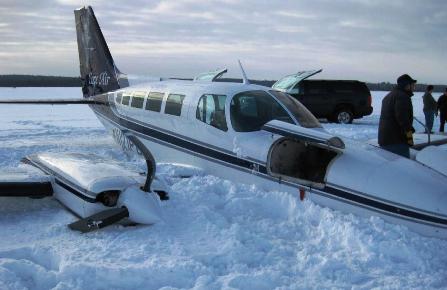A just released factual report on the 1 February 2010 overrun by a Cape Air Cessna 402C shows that the lone pilot ignored aircraft handbook procedures after experiencing an airspeed indicator anomaly while approaching Watertown airport in New York with six passengers.
Due to the low airspeed reading, the pilot flew the aircraft faster than usual, settling on the snow-covered runway at approximately the midpoint of the 1,524m (5,000ft)-long runway at the non-towered airport.
The twin-Cessna came to rest in deep snow 111m beyond the end of the runway. All three landing gears had collapsed and the six propeller blades had been bent aft, but none of the occupants were injured.
 |
|---|
©FAA |
According to the pilot, the pilot's side airspeed indicator had decreased from 140kt to 85kt as Flight 1805 from Albany entered the traffic pattern at Watertown, prompting him to "push the aircraft's nose down and apply maximum power", said the NTSB.
Due to the deteriorating weather conditions, the pilot decided to land rather than to climb to a higher altitude to troubleshoot the problem.
The pilot told investigators he did not cross check the copilot's side airspeed indicator, as called for by the pilot's operating handbook in situations where airspeed readings do not reflect the appropriate trend after initiating a climb or descent. Given the weather conditions, the pitot heating system that warms both independent airspeed measurement systems should have been turned on to prevent ice build up from causing erroneous airspeed readings.
"The inspectors reported that many of the cockpit switches remained on, but that the de-ice boots, stall warning vane, leading edge light and pitot heat switches were in the "OFF" position," the report stated regarding the post-crash inspection. "These switches were located in close proximity to one another on the left side of the instrument panel." Both the pitot-static system, after accounting for landing damage, and the pitot heat function were found to operate normally after the accident.
The pilot said he had been wearing gloves and may have inadvertently switched off the pitot heat and stall warning vane heat switches while securing the aircraft and shutting down various systems after the overrun.
The same aircraft (N121PB) flying with Cape Air was involved in a runway overrun in 1997 after landing with a strong tailwind in Hyannis, Massachusetts. The aircraft exited the runway onto a soft overrun area where the right main gear collapsed.
"Five days after the accident, the airline issued parameters for arrivals and departures from the airport, which included landing with a maximum tailwind of 10kt," the NTSB probable cause for the 1997 overrun stated.
Source: Air Transport Intelligence news























